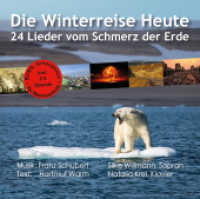Full Description
All the arts painting, sculpture, architecture, urban design, interior design, graphic design, photography, film, fashion, the theatre, and opera have played a role in creating the enduring spirit of Paris. From a primitive village huddled on an island in the middle of the Seine, Paris rose to glory as a medieval and Renaissance centre for art, as the cradle of the Enlightenment, and as the crucible of modern art and architecture. It remains a world centre of innovation in art, architecture, and design, and one of the most thoroughly pleasurable of all modern cities.
Assembled under the editorial direction of Michel Laclotte, former director of the Musee du Louvre, and with the participation of outstanding scholars on both sides of the Atlantic, The Art and Spirit of Paris spans more than 6,000 years of cultural history. In two volumes, comprising nine insightful and wide-ranging chapters, and with approximately 1,500 illustrations, the authors chronicle the history of the visual arts in Paris, tracing their evolution and that of the social systems that supported them.
Volume I introduces the Gallo-Roman settlement described by Caesar and unearthed by modern archaeologists, literally the foundation of modern Paris. From these beginnings, chapter 2 takes the reader through the dark period of the early Middle Ages, when Paris was ravaged by Norsemen, through the long process of rebuilding that led to the flowering of the Gothic and the remarkable masterworks of architecture and stained glass, Notre-Dame-de-Paris and the Sainte-Chapelle. The Renaissance city and the centre of the Enlightenment are the subjects of chapters 3 and 4, illustrated by the masterpieces of painting and the decorative arts that established Paris, by the eighteenth century, as the Western world's centre of the arts.
Volume II begins at 1800, as Napoleon consolidates his power and resolves to make Paris the most beautiful city the world has seen. Chapter 5 treats his brief era, which would echo in the French imagination for decades after, and which begins the reign of Paris as "Capital of the Nineteenth Century." The battles of classicism and romanticism and the advent of a modern "engineer's architecture" of glass and iron are followed in chapter 6 by the glorious Ville Lumiere of Second Empire Paris, with its remarkable world's fairs. It treats as well the aftermath of the Commune, when a "New Painting" would be invented by the most beloved artists of the French tradition, including Manet, Renoir, Monet, and Cezanne. Chapter 7 brings us to fin de siecle Paris, the Belle Epoque, and the run-up to World War I, when a remarkable coterie of artists, including Picasso, invent an art for the new century. Chapter 8 examines the period between the wars, an era of refinement and consolidation in the arts, and chapter 9 brings the story of Paris up to the present, examining the remarkable ways Paris has yet again remade herself, as a city of spectacle and guardian of her remarkable past, while remaining a vital centre of fashion, theatre, and the visual arts.
Contents
Table of Contents from The Art and Spirit of Paris VOLUME I Editor's Note Introduction - Michel Laclotte Portfolio: The View From Above The Origins: From Lutetia To Paris Neolithic Period--A.D. 300 Venceslas Kruta Portfolio: The Seine II. Medieval Paris: The Flowering of an Artistic and Political Capital 300--1527 Alain Erlande-Brandenburg Late Antiquity to the High Middle Ages Romanesque Art (late 10th century--1135) Early Gothic Art (c. 1135--c. 1190) High Gothic (1190--1230) Rayonnant Gothic (1230--1300) The Conquest of the New Style (1240--1260) The Last Years of the Thirteenth Century The Emergence of a Court Style (c. 1300) Courtly Art (1320--1360) Flamboyant Gothic: From Royal to Bourgeois Art (after 1360) An Age of Princes (1380--1436) The Ascendancy of the Bourgeoisie (1436--1520) Portfolio: Stone and Metalwork III. The New Rome 1527--1700 Claude Mignot Introduction Renaissance Paris (1527--1594) The Century of Louis XIII (1594--1660) Paris or Versailles (1660--1700) Portfolio: Unseen Paris IV. Regence to Revolution 1700--1799 John Goodman Paris as the Center of Luxury and Skepticism Sensation and Invention: The Ascendency of the Moderns The Neoclassical Turn: Sparta versus Imperial Rome The City Transformed Emulation and Contestation: Painting and Sculpture (1770--1789) Revolution: Destruction and Regeneration Portfolio: Streets and Boulevards V. Capital of the Nineteenth Century 1800--1851 Christopher Lyon and Michael Marrinan The Last Monarchs Napoleonic Paris Staging the Drama of Empire David and His Followers The Advent of Romanticism Imagining the Past "Engineer's Architecture": From Galeries to Gares Reshaping Paris The Triumph of the Romantics The Monarchy of the Middle Class Notes Bibliography (General and Chapters 1-5) VOLUME II VI. La Ville Lumiere 1852--1889 The Second Empire: 1852--1870 Gary Tinterow Napoleon III and His Court The New Louvre The Exposition Universelle of 1855 The Salons The Exposition Universelle of 1867 Japonisme Napoleon III, Haussmann, and the Transformation of Paris The Paris Opera The Third Republic: 1870--1889 Andrew Carrington Shelton "L'Annee terrible": The Siege of Paris and the Commune A Return to "Moral Order" Worldly Women The New Painting Portfolio: Gardens VII. Modernism and Memory 1889--1914 Jeffrey Weiss Science and Style Symbolism and the Post-Impressionist Retreat The Compromise of Public Art Art Nouveau The Aesthetic of the Street Painting: Bourgeois Salons to Bohemian Montmartre Modernism and the Marketplace Modern Classicism The Camera Cubism: The Fragmented and Inscribed City Epilogue: The Melancholy of Departure Portfolio: Paris By Night VIII. Paris in War and Peace 1914--1945 Malcolm Gee From War to War The Visual Arts in Wartime Paris The International Expositions of 1925 and 1937 Paris as an Art Center Between the Wars The Art Dealers and the Collectors Painting and Sculpture after Cubism The Modern Habitat Entertainment, Spectacle, and Adornment Art Debates of the 1930s Vichy Portfolio: Markets and Shops IX. From Liberation to the Twenty-First Century 1945--Present Francoise Levaillant The Postwar Period (1944 to the 1960s) The Triumph of Abstraction in the 1950s Metamorphoses of Painting and Sculpture after 1960 The Renewal of Public Space in Paris Fashion and Design Architectural Visions and the New Cultural Axes of the Capital Postscript: Paris as Spectacle Portfolio: Cafes and Brasseries Notes Bibliography Chronology Acknowledgments About the Authors Index Picture Credits








